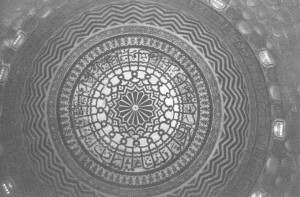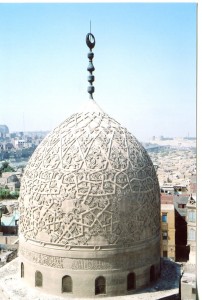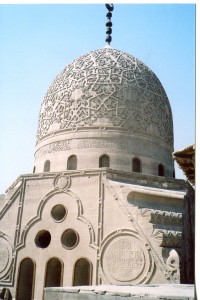You’d think a circle is a circle.
The most basic description of a circle in Western culture is a line around a central point, which is equally distant from the center throughout its length. So, Westerners have usually conceived a circle in terms of its outer edge’s static shape. But other cultures conceive of this basic geometric shape in other ways. Islamic concepts of the circle are some of the world’s richest. We’ll explore them in this post–come into it’s center.
Islamic thought assumes that the center, rather than the perimeter, is the circle’s most basic component. A very rich web of ideas encourages this conception:
1. The universe is created from the center, where God is. The above picture shows the inside of a dome in a Cairo mosque. Light and dark lines emanate from the center, as though God is dividing the day and night, and the seasons. Then energy seems to issue forth. The shapes then become more distinct, as though all the world’s places and species are being established. Then, language and writing emanate. Then come more patterns. So, the circle isn’t the static shape that Westerners have often emphasized since Euclid. It’s dynamic–it embodies creation coming from God.
2. Salat (ritual prayer). All believers bow towards Mecca. This is one of the 5 pillars of faith. All of God’s followers around the world become a circle, and face the same direction to praise the One who created all. So, salat and the dome reflect each other.
The circle represents God’s relationship with His creation, and the dome and salat symbolize the whole universe being created by Him. But from ancient Greek temples to Gothic cathedrals, Westerners have often treated a religious building as a line that approaches the divinity.
The mihrab in mosque architecture also encourages people to see the circle’s center as its most basic component.
Chinese have traditionally seen circles in terms of yin/yang energy flows–there’s less focus on the center, and on the edge, and more on smooth circulation of energies throughout the whole.
You can see a lot of cultural wealth in the ways different societies think of basic geometric shapes. What seems most basic ain’t so–it reflects an infinite cultural landscape.




Comments on this entry are closed.